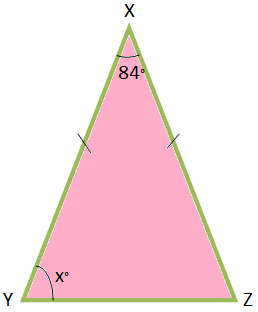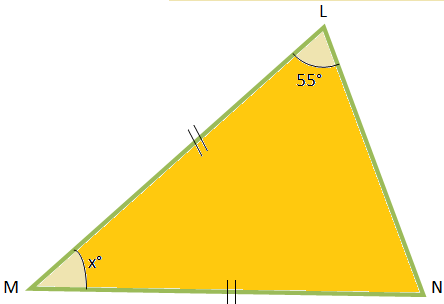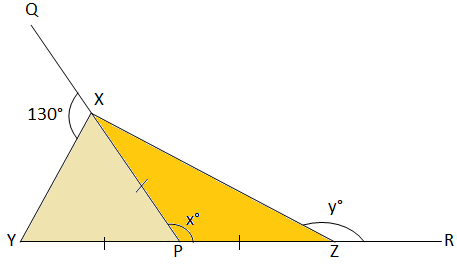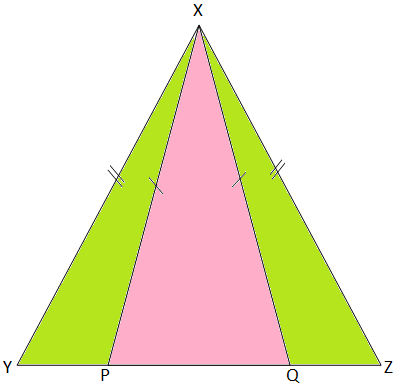Subscribe to our ▶️ YouTube channel 🔴 for the latest videos, updates, and tips.
Problems on Properties of Isosceles Triangles
Here we will solve some numerical problems on the properties of isosceles triangles.
1. Find x° from the below figures.
Solution:
In ∆XYZ, XY = XZ.
Therefore, ∠XYZ = ∠XZY = x°.
Now, ∠YXZ + ∠XYZ + XZY = 180°
⟹ 84° + x° + x° = 180°
⟹ 2x° = 180° - 84°
⟹ 2x° = 96°
⟹ x° = 48°
2. Find x° from the given figures.
Solution:
LMN, LM = MN.
Therefore, ∠MLN = ∠MNL
Thus, ∠MLN = ∠MNL = 55°, [since ∠MLN = 55°]
Now, ∠MLN + ∠LMN + ∠MNL = 180°
⟹ 55° + x° + 55° = 180°
⟹ x° + 110° = 180°
⟹ x° = 180° - 110°
⟹ x° = 70°
3. Find x° and y° from the given figure.
Solution:
In ∆XYP,
∠YXP = 180° - ∠QXY, as they form a linear pair.
Therefore, ∠YXP = 180° - 130°
⟹ ∠YXP = 50°
Now, XP = YP
⟹ ∠YXP = ∠XYP = 50°.
Therefore, ∠XPY = 180° - (∠YXP + ∠XYP), as the sum of three angles of a triangle is 180°
⟹ ∠XPY = 180° - (50° + 50°)
⟹ ∠XPY = 180° - 100°
⟹ ∠XPY = 80°
Now, x° = ∠XPZ = 180° - ∠XPY (linear pair).
⟹ x° = 180° - 80°
⟹ x° = 100°
Also, in ∆XPZ we have,
XP = ZP
Therefore, ∠PXZ = ∠XZP = z°
Therefore, in ∆XPZ we have,
∠XPZ + ∠PXZ + ∠XZP = 180°
⟹ x° + z° + z° = 180°
⟹ 100° + z° + z° = 180°
⟹ 100° + 2z° = 180°
⟹ 2z° = 180° - 100°
⟹ 2z° = 80°
⟹ z° = \(\frac{80°}{2}\)
⟹ z° = 40°
Therefore, y° = ∠XZR = 180° - ∠XZP
⟹ y° = 180° - 40°
⟹ y° = 140°.
4. In the adjoining figure, it is given that XY = 3y, XZ = 7x, XP = 9x and XQ = 13 + 2y. Find the values of x and y.
Solution:
It is given that XY = XZ
Therefore, 3y = 7x
⟹ 7x - 3y = 0 ............................ (I)
Also, we have XP = XQ
Therefore, 9x = 13 + 2y
⟹ 9x – 2y – 13 = 0 ............................ (II)
Multiplying (I) by (II), we get:
14x - 6y = 0 ............................ (III)
Multiplying (II) by (III), we get:
27x – 6y – 39 = 0 ............................ (IV)
Subtracting (III) from (IV) we get,
13x - 39 = 0
⟹ 13x = 39
⟹ x = \(\frac{39}{13}\)
⟹ x = 3
Substituting x = 3 in (I) we get,
7 × 3 – 3y = 0
⟹ 21 – 3y =0
⟹ 21 = 3y
⟹ 3y = 21
⟹ y = \(\frac{21}{3}\)
⟹ y = 7.
Therefore, x = 3 and y = 7.
From Problems on Properties of Isosceles Triangles to HOME PAGE
Didn't find what you were looking for? Or want to know more information about Math Only Math. Use this Google Search to find what you need.






New! Comments
Have your say about what you just read! Leave me a comment in the box below. Ask a Question or Answer a Question.